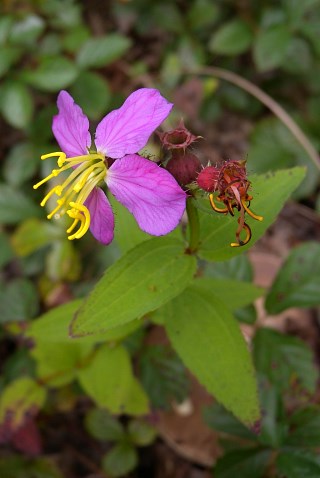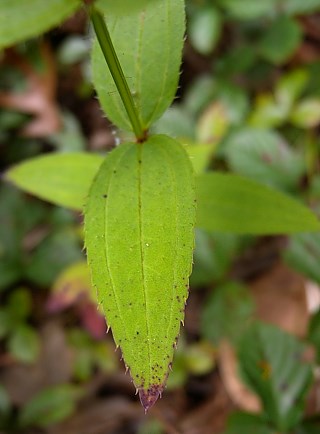Description: This herbaceous perennial wildflower is ½–2½' tall and largely unbranched, except near the apex where some lateral stems with flowers are usually produced. Short plants are erect, while tall plants sometimes sprawl across the ground. The central stem is light green to purplish green, sharply 4-angled, narrowly winged, and sparsely to moderately covered with glandular hairs. Pairs of opposite leaves occur along the central stem; they are up to 3" long and 1¼" across, medium green, sharply toothed and ciliate along their margins, hairless to slightly hairy across their upper and lower surfaces, and sessile. The central stem and upper lateral stems (if present) terminate in short cymes of showy flowers. The branches of each cyme are usually glandular-hairy.

Each
flower is 1–1½" across, consisting of 4 widely spreading petals that
are pink to deep rose-pink, a tubular calyx with 4 widely spreading
triangular teeth, 8 stamens with bright yellow to orange-yellow
anthers, and a 4-celled ovary with a single long style. The tubular
calyx is shaped like a vase with a constricted neck; it is covered with
long bristly hairs. The long slender anthers are curved like a sickle;
the pollen of each anther is released through a small pore at one end.
The blooming period occurs from mid-summer to early fall and lasts
about 1-2 months. Each flower is replaced by a seed capsule that
remains hidden within the persistent calyx; the calyx becomes red to
purplish red after the petals fall off the flower. Each seed capsule
contains numerous tiny seeds that are less than 1 mm. in length. The
root system is fibrous; some fibrous roots have tuberous swellings.
This wildflower reproduces by reseeding itself.
Cultivation:
The preference is full sun to light shade, wet to moist conditions, and
an acidic sandy soil. Soil containing sphagnum moss or non-alkaline
gravel is tolerated as well. In very sunny areas, Virginia Meadow
Beauty is often partially shaded by taller plants.

Range & Habitat:
The native Virginia Meadow Beauty is uncommon in Illinois; it is found
in the NE
section of the state and scattered localities elsewhere (see Distribution
Map). Habitats include wet sandstone depressions in upland
woodlands, sandy
swamps, soggy sandy thickets, wet to moist sand prairies, acidic
gravelly seeps, interdunal swales, sandy marshes, sandy borders of
ponds and lakes, edges of sandy paths in areas that are prone to
flooding, and sandy ditches. This wildflower is usually found in high
quality natural areas.
Faunal Associations:
The flowers are cross-pollinated primarily by bumblebees, which collect
pollen using 'buzz pollination.' This is accomplished by the rapid
vibration of the thoracic muscles on the anthers to release their
pollen through small pores. The polyphagous caterpillars of the moth Scopula
limboundata (Large Lace Border) feed on the leaves of Rhexia
spp. and many other plants. Because the hairy reddish fruits
are somewhat sticky, they may attach themselves to the fur or feathers
of passing animals, thereby distributing the seeds into new areas.
Photographic Location:
Along the edge of a path in a sandy swamp at the Iroquois County
Conservation Area in Iroquois County, Illinois.
Comments:
Virginia Meadow Beauty has beautiful flowers with rather odd-looking
and showy anthers. Other Rhexia spp. have flowers
with similar anthers. The only other species of this genus in Illinois
is Rhexia mariana (Pale Meadow Beauty). This latter
species differs from Virginia Meadow Beauty by the more pale color of
its petals (nearly white to pale pink), the lack of winged extensions
on its stems, and its more narrow leaves, which are more lanceolate
than ovate in shape. As a result, these two species are fairly easy to
distinguish. There are additional Rhexia spp. in
the southeastern section of the United States. Other common names for
these species are Handsome Harvey, Deergrass, and Meadow Pitchers. This
last name probably refers to the shape of the fruits.